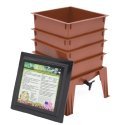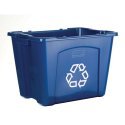Earthworms in soil and composting
by Kelly Slocum
There are more than 4400 named species of earthworm on this planet, and researchers have broken them into three categories, largely descriptive of their habits in the soil. These three categories are endogeic, anecic and epigeic.
Endogeic worms build complex lateral burrow systems through all layers of the upper mineral soil. These worms rarely come to the surface; instead spending their lives in these burrow systems where they feed on decayed organic matter and bits of mineral soil. They are the only category of worm which actually eats significant volumes of SOIL and not strictly the organic component. Endogeic worms tend to be medium sized and pale colored.
Anecic worms (like the common nightcrawler Lumbricus terrestris) build permanent, vertical burrows that extend from the soil surface down through the upper mineral soil layer. It is not unusual for their burrows to reach a depth of six feet or more. These worm species coat their burrows with mucous which stabilizes the burrow so it does not collapse, and build little mounds (called middens) of stone and castings outside the burrow opening. Anecic worms are able to recognize their own burrows, even in an environment where there are hundred of other burrows present and return to these burrows each day.
The anecic species feed in decaying surface litter, so come to the soil surface regularly, which leaves them exposed to predators. They developed a spoon shaped tale that bristles with little retractable hairs, called setae, with which to grip the burrow wall and avoid being easily pulled out. They also tend to be very large worms and have bellies with less pigmentation than their backs. These worms have a long generation time, do not do well in high density culture and require the stable burrow environment in order to thrive. In the absence of this burrow, anecic worms will neither breed nor grow.
The worms we use in vermicomposting systems, like Eisenia fetida (commonly called the redworm), are in the epigeic category. In nature epigeic worms live in the top soil, and duff layer on the soil surface. These small, deeply pigmented worms have a poor burrowing ability, preferring instead an environment of loose organic litter or loose topsoil rich in organic matter to deeper soils. Epigeic species feed in organic surface debris and have adapted beautifully to the rapidly shifting, dynamic environment of the soil surface.
We use epigeic worms in vermicomposting because we can duplicate their ideal environment in a bin or bed, because they are voracious processors of organic debris, because they do well in high density culture, and because they are so very tolerant of a wide range of environmental conditions and fluctuations.
Among the epigeic species there are several dozen that have become naturalized to North America. It is widely believed that all native worm species were wiped out by glacial activity thousands of years ago and that those now supported in North American soils were introduced from Europe with explorers and settlers. While the recent articles about non-native species causing damage to US forests are interesting and worth noting, few soil ecologists feel that earthworms pose a major threat.
The epigeic worm species Eisenia fetida is found on nearly every land mass of this planet, with Hawaii being a notable. Regardless, there are typically multiple epigeic worm species in most regions of the US that process organic surface litter. In the southern states, for instance, where E. fetida is prolific, at least two other worm species suitable for vermicomposting systems are common to area soils, Amynthas gracillus and Perionyx excavatus. This is not to say these are the ONLY other species present in these soils, but they are two that are routinely found south of the Mason Dixon line and in many areas of irrigated soils in the southwest. Northern soils are home to many worm species, including E. fetida, but no A. gracillus or P. excavatus as these species cannot tolerate cool temps for any length of time. Alaskan soils support rich populations of E. fetida worms, which can survive the extreme winters. Admittedly the adults are typically killed by the freeze, but the amazing little cocoons can easily survive being frozen solid for many months, hatching healthy young when the spring thaw arrives.
In every region of the world there are worms adapted to the local soils. Not every place has had a taxonomic survey done, so researchers do not always know which worms may be present in a given area, but it’s fairly certain that wherever you are there is a worm adapted to converting surface debris to topsoil. When a composting or vermicomposting system is in soil contact naturalized earthworms will be drawn to the system when and if it meets their environmental requirements. Local epigeic species will all live happily side by side, processing vast amounts of organic debris, and the one best adapted to the particular bin environment and local climate will be the species that ultimately dominates the system. In most areas of the US this worm will be E. fetida, though P. excavatus is sometimes the dominant species in composting systems in the southern states. In systems in soil contact it is also fairly common to find anecic species like the common nighcrawler investigating the bin. It is highly unlikely they will set up residence IN the system, but will visit the bin to find a nice meal before returning home to the comfort of its burrow.
Earthworms are an incredibly varied and adaptable group of animals that are so common in our world that they often go unnoticed and unsung. We are far more dependant on them than we realize, and are fortunate that they are so eager and able to rise to the challenges we pose them!





